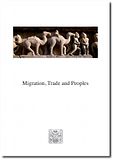Migration, Trade and Peoples
Willis, Michael (Hrsg.)
Migration, trade and peoples : European Association of South Asian Archaeologists ; Proceedings of the eighteenth congress, London, 2005 / Michael Willis, general editor. - London : The British Association for South Asian Studies, The British Academy, 2009. - iii, 189 S. [Online-Publikation]
ISBN 978-0-9553924-5-0
URL: Royal Asiatic Society of Great Britain and Ireland
Beschreibung
Trade and exchange across the Indian Ocean has deep historical roots. The movement of people and goods can be traced to at least the second millennium BCE, with volumes increasing substantially in Roman times. This is shown by numerous Roman finds in the port and hinterland cities of western India and Sind, as well as the adaptation of Ptolemaic astronomy in India in the early centuries CE. There seems to have been a gradual abatement in the centuries prior to the rise of Islam, after which links across the Indian Ocean were reactivated. The consolidation of the Delhi Sultanate under the Tughluqs in the fourteenth century led to an intensification of activity, encouraged in part by the institution of pilgrimage to Mecca and Medina.The fourteenth century also witnessed much expansion toward South East Asia and China.
The ways in which the Indian Ocean brought together an array of societies with different histories, economies, languages and religious traditions over several thousand years makes any study centered on the Indian Ocean a daunting task. The complex nature of the subject necessitates a careful focus on a specific period and set of research problems. For the seminar in October, the participants intend to look at the late antique period from the Roman occupation of Egypt to the rise of Islam in the early seventh century CE. This timeframe is justified in that it starts during the heyday of eastwest trade and ends with the appearance of Islam, a new political and socio-religious dispensation that fundamentally changed the geographical horizon and dynamics of movement across the Indian Ocean.
Editors: Roberta Tomber, Lucy Blue, Shinu Abraham
Editor: Dr Christine Frölich
Editor: Asko Parpola
Die drei Teile sind jeweils als PDF-Datei verfügbar.
Ähnlich
- Pfisterer: Hunnen in Indien
- The Ancient Monastic Complex of Dangkhar
- Tepe Narenj à Caboul
- Connections and Complexity
- Foreign Sailors on Socotra
- New Dimensions in Tamil Epigraphy
- Glory of the Kushans
- Human Skeletal Remains from the Medieval Site of Sanjan
- Dictionary of Social, Economic, and Administrative Terms in South Indian Inscriptions
- The Oxford Handbook of the Archaeology of Ritual and Religion

